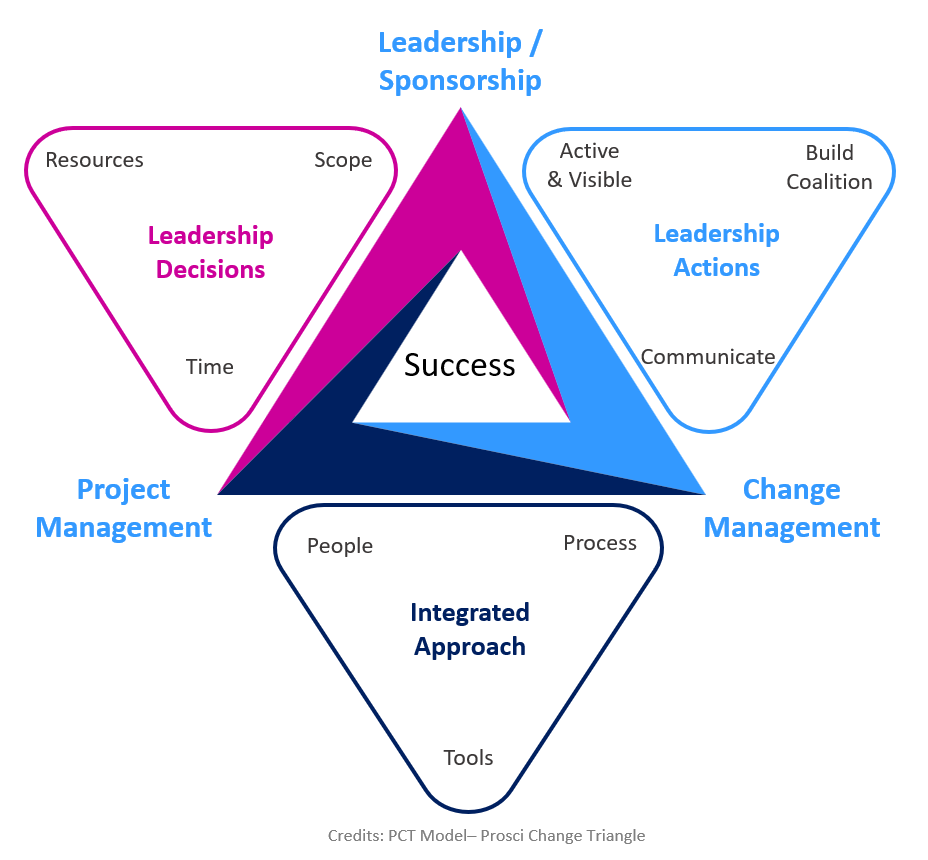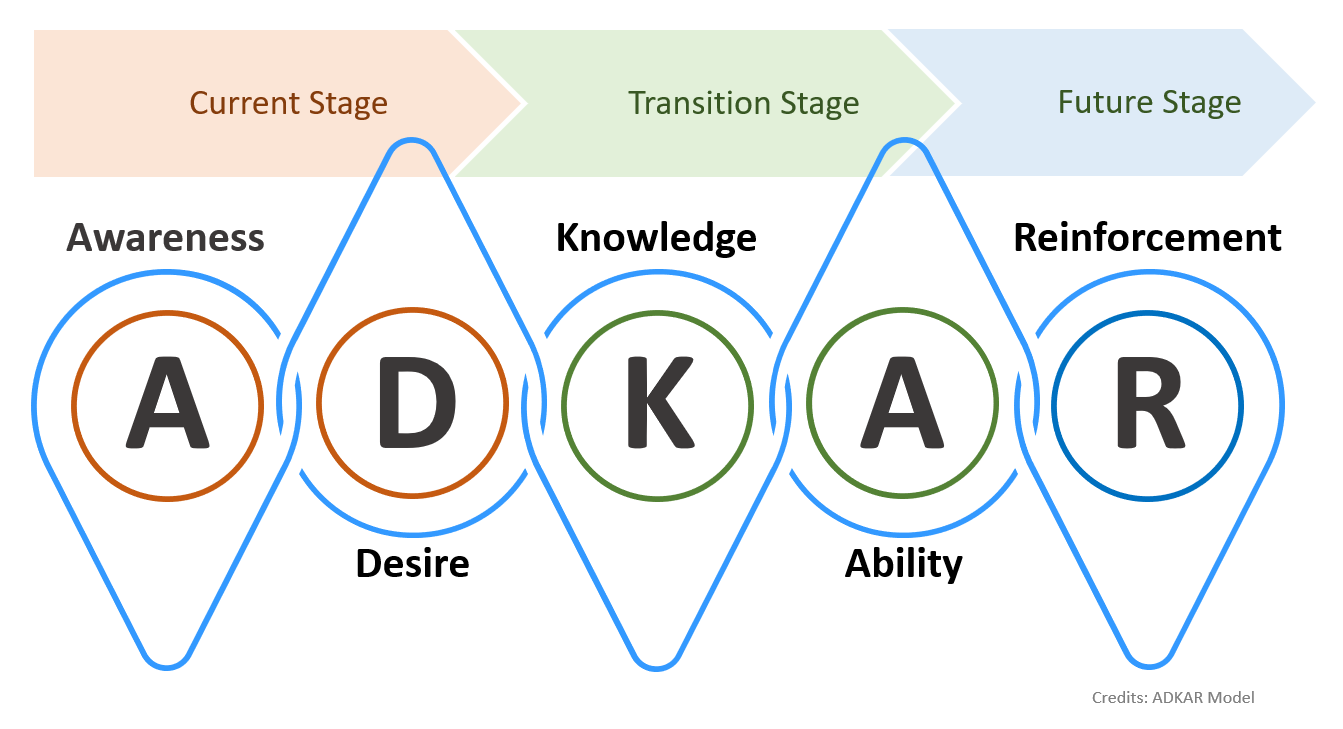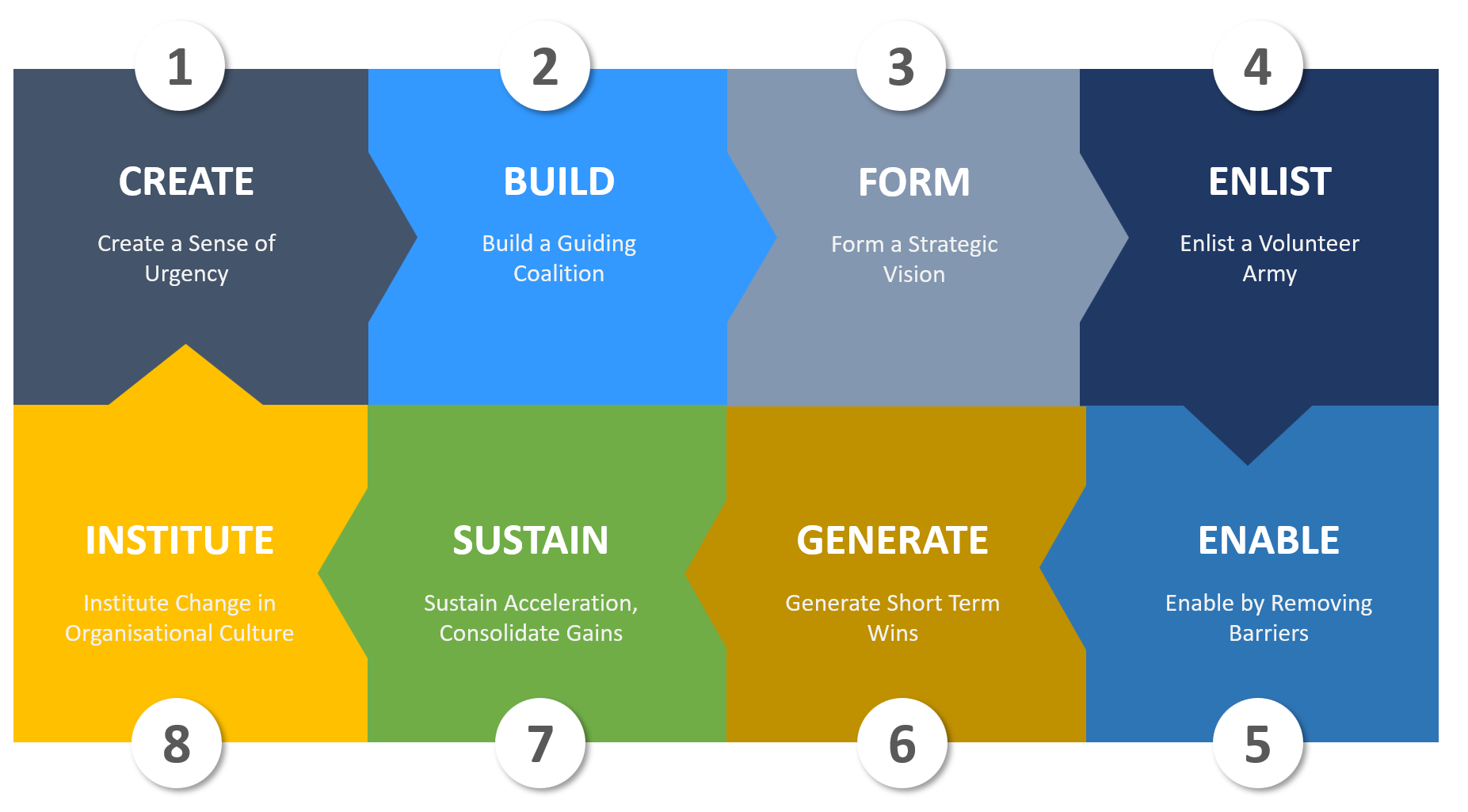Published by: Tamer Elogueil
In today's dynamic business landscape, change is not just inevitable—it's essential for survival. But how can organisations ensure that transitions are smooth, resistance is minimised, and employee engagement is maximised? The answer lies in harnessing powerful tools and frameworks tailored to support this journey.
Tools such as ADKAR model and Kotter’s 8 Steps Approach are among the most famous tools that can support this transition.
Organisational Level: Crafting a Structured Process
The Prosci 3-phase process provides a structured framework for driving organisational change at an organisational level.
Phase 1 - Prepare Approach: leadership need to define how success looks like, define the impact of this change on business, customers and people in the organisation, and define the approach that best suits the business.
Phase 2 – Manage Change: subject matter change management team need to prepare a plan and act, track performance through each stage and adapt actions as necessary to ensure smooth transition this include managing change resistance.
Phase 3 – Sustain Outcomes: achieving the change is a great achievement by itself and sustaining the outcomes is as detriment. There need to be and ongoing performance review to ensure that change is bringing the desired outcomes, activate sustainment, and transfer the ownership from the change management team to the final stakeholders to manage it way forward.
Essential Elements of Successful Change
To maintain a successful change. Prosci introduced a PCT model which is a simple yet powerful framework that show the three critical aspects of any successful change effort:
1. Leadership/Sponsorship: represents the strategy and direction that will lead a change initiative or project provided by those who have the authority and resources to launch the effort
2. Project Management: represents the technical aspect of change. This is achieved by designing, developing and implementing the solutions that addresses an opportunity of change.
3. Change Management: represents address the people side of change, enabling people to engage, adopt and utilise the solution in day-to-day work.
The triangle sides represent how the three corners’ aspects connect:
Leadership Decisions: this presents the relationship between the leadership/sponsorship and the project management which connects the decisions the executives make towards the projects scope, resources that will be deployed into the project and time.
Leadership Actions: this highlights the relationship between the leadership/sponsorship and the change management aspect. This involves the leadership/sponsorship performing the three critical roles required to ensure the initiative or project success by actively and visibly participate in the change project, build a support coalition, and adapt a direct open communication with the employees.
Integration Approach: it refers to relationship between project management and change management this is presented by people who will do the work, the process to how the work will get done, and the tools used to do the work.

Managing People through Change
Developed by change management expert Jeff Hiatt, ADKAR is an acronym for five key outcomes organisations need to achieve for successful change.
Implementing ADKAR: A Step-by-Step Approach
The ADKAR model breaks down the change journey into three distinct stages:
Current Stage (Awareness & Desire): Leaders communicate the "what" and "why" of the change, building a strong case for its necessity. Additionally, they foster a sense of desire by aligning the change with employee values and incentives.
Transition Stage (Knowledge & Ability): This stage equips employees with the tools they need to navigate the change. Training programmes, coaching, and on-the-job learning opportunities empower individuals to develop the required skills and knowledge.
Future Stage (Reinforcement): Positive reinforcement mechanisms like recognition and rewards solidify the change and prevent employees from reverting to old habits. This fosters a culture of continuous improvement and adaptation.

Awareness: Employees understand the "what" and "why" behind the impending change.
Desire: Employees see the benefits and are motivated to embrace the change.
Knowledge: Employees possess the necessary skills and knowledge to implement the change.
Ability: Employees can confidently apply their knowledge and perform in the new environment.
Reinforcement: Positive reinforcement mechanisms sustain the change and prevent regression.
The ADKAR model power is that it offers a multitude of benefits for organisations:
1. Enhanced Strategic Focus: Aligns everyone with the change goals for a unified approach.
2. Improved Employee Engagement: Creates a sense of ownership and fosters a positive attitude towards change.
3. Greater Agility: Equips the organisation to adapt and thrive in a dynamic business environment.
4. Sustainable Change: Ensures long-term success by reinforcing desired behaviours.
Beyond ADKAR: Exploring Complementary Models
While ADKAR focuses on individual change, consider exploring other models like Kotter's 8-Step Change Approach for a more comprehensive approach for managing individual change in more systematic approach. Understanding the strengths of the model allows you to leverage diverse approaches for optimal change management. Let’s dive in to the 8 steps:

1. Create a Sense of Urgency: the support of the whole organisation is deemed necessary. Kotter suggest that 75% of the company management need to “buy-in” the change for the change to be successful. People side discussion after communicating about the change need to happen, this will build the urgency and feed it on itself, you just need to build up and steer from here.
2. Build a Guiding Coalition: through getting the executives and top management buy in. This gives the change team the momentum for implementing it and removing obstacles. Without the buy in, initiatives struggle and ultimately fail.
3. Form a Strategic Vision: alignment increase the chances for success. A clear vision has to be in place to make sure everyone involved on the same page and heading in the same direction. This need to be capsulated in a powerful one or two sentences.
4. Enlist a Volunteer Army: communication is everything. Kotter emphasis that leader need to constantly communicate the key strategies. This need to be frequent and informal face-to-face with your people. You need to build a network that help you communicate change and provide a feedback loop into the change team.
5. Enable Actions by Removing Barriers: empowerment begins with removing obstacles and barriers. This stage where you change initiative moves beyond planning and into practical action. You need to constantly check for barriers, obstacles and people resisting change. Empower people to execute the vision and take risks.
6. Generate Short-term Wins: Success generate success. Small wins give people an insight of how the vision will look like. Create short-term target and not only one long-term goal. Ensure it is realistic and achievable.
7. Sustain Acceleration: Kotter argues that many changes initiatives fail because victory is declared too early. Really change runs deep and need continuous improvement. Each success and failure are an opportunity for analysing what worked, what did not, and what need to be improved.
8. Institute Change: any change needs to be sustained and be embedded in the new way of how we do things around here or the new culture. Its is important to articulate the connection between new behaviours and organisational success. Ensure transformation and all its approaches and practices embedded into the organisational culture
Embracing the Future of Change Management
As organisations evolve amidst digital transformation and remote work trends, adaptable and people-centred change management methodologies become paramount. Exploring emerging trends such as AI-powered analytics and a renewed focus on employee experience necessitate adaptable and people-centred approaches to change. And remember, open communication remains the cornerstone of success in navigating change.



Comments
No Comments added, be the first...